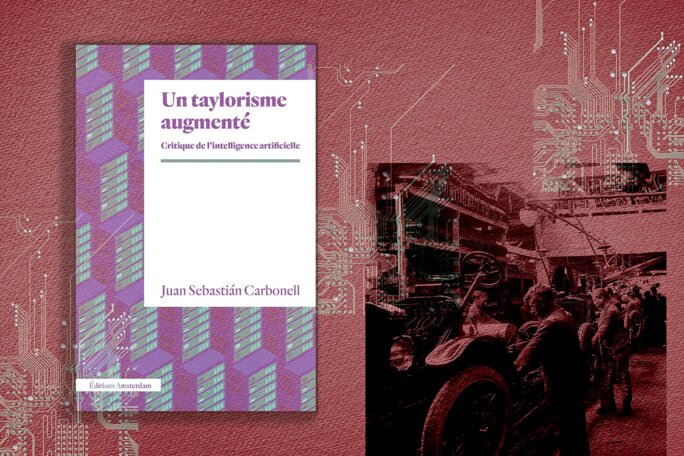Debates about the impact of artificial intelligence (AI) on work and jobs are usually clearly signposted. They come down to two approaches: either it will bring a new economic dynamism driven by higher productivity, or it will lead to a wholesale “disappearance” of jobs as they are replaced by this new technology. The countless conferences on AI involving thousands of managers and bosses are full of such discussions.
The main strength of the latest book by France-based sociologist Juan Sebastián Carbonell, 'Un taylorisme augmenté' ('Enhanced Taylorism'), published by Éditions Amsterdam, is that it blows apart these false debates in order to view the issue of AI from a different and double perspective: critical and social. It is a 'critical' perspective in the sense that the writer refuses to be pushed into tacitly backing this new technology simply on the grounds that it represents “progress” or because of the very fact of its existence.

Enlargement : Illustration 1

“The view put forward here is an invitation to re-politicise technology,” writes Juan Sebastián Carbonell, setting out his argument from the outset. If technology is political, it is because it is not simply the product of remorseless scientific “progress”. Technology is the outcome of social choices that are themselves the result of how society is structured. As a result, there are winners and losers in every technological revolution.
How technologies take hold
And the way that these winners and losers are divided up follows the existing power hierarchy in society. If a technology is presented as “progress” for “society”, then it is, first and foremost, a progress for “society” as it is, in other words for those who dominate it. All the other arguments simply mask this reality.
“A technology does not take hold inevitably because it is more ‘efficient’, but because those who control the economic means, seeing it as fitting their interests better, choose to make it real,” the author says. In other words, change in technology is always constructed, and it is always constructed with a purpose in mind. It is here that the political aspect is so crucial.
Technologies in general, and AI in particular, are therefore social constructs. “Technological change has many paths,” the writer points out, as he sets out in detail the media, economic and political mechanism that makes AI look as if it is inescapable.
First of all, industry comes up with “technological expectations” which are then relayed by the media. These hopes build a “dream” and steer funding and research in a very precise direction. “Predictions of AI come true, not because the predictions are right, but because the right actors seize upon the right promises at the right time,” writes Juan Sebastián Carbonell.
This first part of the book thus has a political role in the form of a warning: that the workers’ movement needs to get rid of the ingrained habit of seeing every technology pushed by capitalism as progress and as an unquestionable aspect of modernity.
In the specific case of AI, Juan Sebastián Carbonell highlights its true role in the overall organisation of modern capitalist work. This is the function of what he calls “enhanced Taylorism”, using the term for scientific management that comes from the work of the influential late 19th and early 20th century American engineer and manager Frederick Winslow Taylor. From this perspective, the issue is no longer about “jobs disappearing”, as the media clamour seeks to convince us, but far more about the “degrading of work by companies”.
'Enhanced Taylorism'
To reach this conclusion, the writer puts aside the usual way of looking at the impact of AI on work, that of the effects of “polarisation” and “reskilling”. According to this traditional view, technology favours the rise of highly-skilled tasks, leading to an overall rise in job skills. But at the same time, jobs become split, with growing gaps between skilled and unskilled work. This is the “polarisation” effect.
But for the author, the impact of AI does not work in this way. To see why, one must grasp that the split between skilled and unskilled jobs is largely false. It leaves out the job’s content: what it produces, how it is produced and with what it is produced. This content itself brings about levels of routine and freedom that are independent of the job’s own skill rating. And AI is involved in the content of tasks that are seen as skilled.
The nature of this intervention by AI does not mean that jobs are simply replaced, as is too often stated. What AI instead does is strip out the freedom and craft of a job by automating a certain number of tasks. The job then changes nature: it is boxed in by what AI does, it becomes “parcelled up” and “standardised”, and dependent on AI’s actions. It is at this level that AI has a 'Taylorist' function.
Juan Sebastián Carbonell reminds us that Taylorism is not just about the “assembly line” (a concept in fact unknown to Taylor in his day) and the stopwatch, it is first and foremost a fight against workers’ know-how in all its forms. It is thus a theory that involves the control of work through breaking it down into small constituent parts. As the writer notes, Taylorism did not vanish with the assembly line, on the contrary, it “ended up merging with how work is organised”.
But since the urge for capital accumulation never ends, this Taylorism must always “improve”. Technologies are therefore brought in to “strengthen the dynamics of parcelling the work up and of the division between design and execution”. And it is here that AI comes into its own.

Enlargement : Illustration 2

This technology does not lessen the need for work, quite the opposite. Without the upstream work of “microworkers” with insecure jobs – whose role has been highlighted, among others, by the research of Paris-based sociology professor Antonio Casilli - without the downstream work of proofreaders and checkers, and without support work, notably by those who must train the AI, this technology cannot work.
But it does change the way work is done. Juan Sebastián Carbonell gives two clear examples: journalism and translation. These are two jobs said to be “threatened” by AI. But what is really threatened is the freedom and craft of these workers who are now subject to the rhythms and demands of AI. A translator must now work on an already translated text that frames his or her own intellectual work and this leads them to carry out tasks to support the tool... The content of their work is degraded by this, stripped of any “creative craft” and the benefits of experience.
Drawing on the work of the American sociologist Harry Braverman, for whose major work 'Labor and Monopoly Capital: The Degradation of Work in the Twentieth Century' he wrote the preface for the French edition, 'Travail et capitalisme monopoliste, published by Les Éditions sociales in 2023, the writer sees in AI the culmination of “algorithmic management” based on “redundancies or rewards using performance criteria”.
The heart of this management approach is the “asymmetry of information”, which immediately puts the worker in a position of subjection to the boss. And AI reinforces this asymmetry while “freeing” bosses from blame as the machine's demands are portrayed as objective. It is in this way that AI becomes an improved or “enhanced” form of “Taylorism”.
Challenge technology in order to to challenge the domination of capital
To get out of this trap, the writer wants to make AI a “contested arena within the ‘hidden abode’ of production described by Marx”. Here the two strands of the writer’s analysis, the critical and the social, come together. To slow the repressive role of AI, the writer focuses on the invented nature of its supposed progress, so that the real battle can be over whether or not to adopt this technology at all.
No technology is “inevitable”. It only takes hold because it has political backing. And often because it is not seen as an object of social strife. It is in this context that Juan Sebastián Carbonell argues for “neo-Luddism”, drawing on the Luddite movement in England which, in the early 19th century, led workers to smash textile machines.
For the author, Luddism is not backwardness. Indeed, it is on the contrary a “means of shaping change in technology at work”. In other words, it is an act of freedom, in that what is rejected is the hand of capital over the act of production. A rejection of forced technological narratives and of the supposed inevitability of AI then makes it possible to “invent alternative technological routes”.
The writer’s stated wish to integrate the fight against technology with social protest brings him close to some contemporary writers such as the Japanese philosopher Kohei Saito who supports the idea of having a choice over the use of technologies in the move from capitalism to socialism, with some of them being rejected.
The usefulness of Juan Sebastián Carbonell's book is that it always ties practice to theory, but also that it opens up a new path for social struggles, which are too often bogged down in the issues of the cost of living or jobs. The rejection of AI makes it possible to widen the struggle to the daily, concrete domination that capital has over work. This struggle then opens the way to challenge the social bonds of capitalism. What this book tells us is that if AI is seen as a cure-all by capital, then the answer must be to make it the starting point of a challenge to its domination.
- *Juan Sebastián Carbonell, 'Un taylorisme augmenté. Critique de l’intelligence artificielle' ('Enhanced Taylorism. A critique of artificial intelligence'), Amsterdam, Paris, 2025, 176 pages, 13 euros.
------------------------------------------------------------------------------------
- The original French version of this article can be found here.
English version by Michael Streeter


